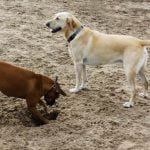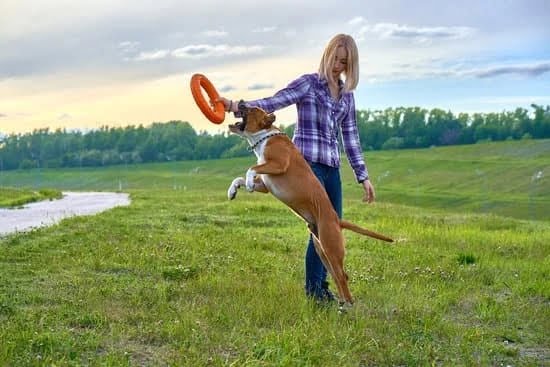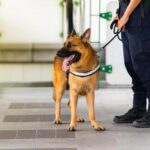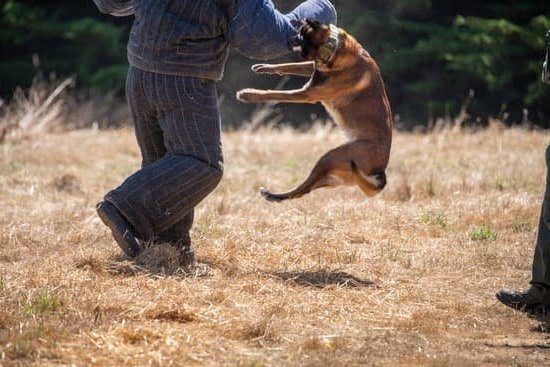Training a sheep dog pup is a crucial step in ensuring their success as working dogs. These intelligent and instinctual animals possess a natural talent for herding, but it is through proper training that they learn to harness these abilities effectively.
This article aims to provide a comprehensive guide on how to train a sheep dog puppy, incorporating essential aspects such as breed selection, foundational commands, leash training techniques, advanced commands, and socialization. By understanding the importance of training and implementing the strategies outlined in this article, you can set your sheep dog pup up for a lifetime of success in their role as a herding companion.
When it comes to training sheep dog pups, selecting the right breed is an important consideration. Factors such as temperament, energy level, and genetic predisposition should be taken into account to ensure compatibility with your lifestyle and specific herding needs. Once the appropriate breed has been chosen, it is vital to prepare your home and environment for training. Creating a safe and stimulating space will enhance learning opportunities for your pup and promote focus and receptiveness during training sessions.
Building a strong foundation is paramount when training sheep dog puppies. Basic obedience commands lay the groundwork for more complex tasks later on. Teaching commands such as sit, stay, come, and heel form the basis of their communication with you as their handler.
Additionally, nurturing their innate herding instincts is key for them to excel in their future roles. By providing appropriate outlets for natural behaviors like stalking or chasing movements through games and controlled exercises, you can help develop their “herding instinct” further.
Choosing the Right Breed of Sheep Dog for Herding
When it comes to training a sheep dog pup, choosing the right breed is crucial. Different breeds have varying instincts and characteristics that can greatly impact their ability to excel in herding tasks. By taking certain factors into consideration, you can ensure that you select a breed that aligns with your specific needs and training goals.
- Size: Sheep dogs come in various sizes, from small to large breeds. The size of the breed can determine their compatibility with the type of livestock you have or plan to work with. While smaller breeds like the Border Collie may be more agile, larger breeds like the Old English Sheepdog may possess greater physical strength for herding larger animals.
- Temperament: The temperament of a sheep dog is another important factor to consider. Some breeds are known for their high energy levels and an intense desire to work, making them more suitable for active individuals or those who have a farm or ample space for them to exercise. On the other hand, some breeds may be more laid-back and less driven by instinct, making them better suited for less demanding herding tasks.
- Trainability: Certain sheep dog breeds are known for their ease of trainability and ability to quickly grasp commands and instructions. These highly intelligent dogs not only learn commands faster but also retain what they have learned for longer periods. If you’re looking for a pup that will pick up on training cues quickly, consider breeds like the Australian Shepherd or the German Shepherd.
Remember that while breed characteristics play a significant role in selecting a sheep dog pup, each individual dog has its own unique personality traits and abilities. It’s essential to spend time getting to know potential pups before making your decision, as this will help ensure a good fit between you, the pup, and your training objectives.
Getting Started
When it comes to training a sheep dog pup, preparation is key. Before you start teaching your new furry friend the basic commands and obedience training, it is essential to create a suitable environment that fosters learning and provides opportunities for growth. Here are some steps to help you get started:
- Create a Safe Space: Designate an area in your home where your sheep dog pup can feel secure and comfortable during training sessions. This could be a specific room or a fenced-off section of your backyard. Ensure that the space is free from any potential hazards such as toxic plants or objects that could harm the puppy.
- Puppy-Proof Your Home: Just like human toddlers, curious puppies are prone to exploring their surroundings with their mouths. Take the time to remove any items that may be tempting for your sheep dog pup to chew on or cause harm. Keep electrical cords tucked away, secure loose objects, and put away any toxic substances out of reach.
- Gather Training Equipment: As you begin training your sheep dog pup, it’s important to have some essential equipment on hand. These include a collar or harness that fits properly, a sturdy leash (preferably 4-6 feet long), treats for rewards, and possibly some toys to keep their attention during training sessions.
Once you have created a safe and conducive environment for training, you will set yourself and your sheep dog pup up for success in their learning journey. Remember, consistency is key when it comes to establishing routines and building trust with your furry companion.
Building a Strong Foundation
When it comes to training a sheep dog pup, building a strong foundation is crucial. This involves teaching them basic commands and obedience training early on. By establishing these fundamental skills, you are setting your pup up for success in their future training endeavors. Here are some important aspects to consider when focusing on building this strong foundation.
First and foremost, it is essential to start with basic commands such as “sit,” “stay,” “lie down,” and “come.” These commands create the groundwork for more advanced training later on. Teaching these commands can be done through positive reinforcement techniques, such as using treats or praise when your pup successfully follows the command. It is crucial to be consistent in your training methods so that your pup understands what is expected of them.
Aside from basic commands, obedience training is another crucial aspect of building a strong foundation for your sheep dog puppy. This includes teaching them how to walk on a leash without pulling or lunging and responding appropriately to cues such as “heel” or “leave it.” By instilling good behavior early on, you are laying the groundwork for successful off-leash training in the future.
To help readers better understand the importance of building a strong foundation through basic commands and obedience training, here are some key benefits:
- Safety: Basic obedience commands help keep your puppy safe, especially when they are around other animals or in potentially dangerous situations.
- Communication: These basic commands create clear communication between you and your pup, allowing for better understanding of expectations.
- Control: A well-trained sheep dog puppy will have better control over their impulses and behaviors, making them easier to manage in various environments.
- Bonding: The process of training creates an opportunity for you and your pup to bond and build trust with each other.
| Benefits of Basic Commands and Obedience Training |
|---|
| Safety |
| Communication |
| Control |
| Bonding |
Developing the “Herding Instinct”
Puppies are born with natural instincts, and one of the most important traits for a sheep dog is the “herding instinct.” This instinct drives the puppy to gather and control livestock, making it an essential characteristic to develop in a sheep dog pup. In this section, we will explore techniques and strategies to nurture and enhance the herding instincts of your sheep dog pup.
- Introduce your pup to livestock: Exposing your puppy to farm animals from an early age is crucial for developing its herding instincts. Start with calm and friendly animals such as younger or more docile livestock. Allow supervised interactions between your puppy and these animals, encouraging gentle curiosity while preventing rough play.
- Provide positive reinforcement: As your pup begins to display natural herding behaviors, reward them with treats or praise. This positive reinforcement will associate their natural instincts with pleasant experiences, further encouraging desired behavior.
- Utilize toys and tools: Incorporate various toys and tools into your training sessions that mimic the movements and actions of livestock. For example, you can use stuffed animals or small balls attached to strings to simulate the movement of a herd. Engage your pup in activities that require focus, agility, and quick decision-making to stimulate their herding instincts.
- Practice controlled obedience exercises: Incorporating obedience training exercises that incorporate elements of herding can help strengthen the connection between commands and instinctual behaviors. For instance, practice commands such as “come by,” “away,” or “lie down” in conjunction with guiding your pup towards a target object mimicking flock movement.
Nurturing the herding instinct in a sheep dog puppy requires patience, consistency, and positive reinforcement. Remember that each pup develops at its own pace, so be patient if progress is slow at first. Through dedication and proper training techniques, you can help your sheep dog pup develop their natural talents into valuable skills for herding livestock effectively.
Effective Leash and Off-Leash Training Techniques
Leash Training
One of the most important aspects of training a sheep dog pup is teaching them to walk calmly on a leash. This skill is crucial for ensuring their safety and the safety of those around them. To begin leash training, start by introducing the puppy to wearing a collar or harness. Allow them some time to get used to the sensation before attaching a leash.
Once your pup is comfortable with their collar or harness, you can begin actually walking on leash. Start by keeping the leash loose and allowing your puppy to explore their surroundings while walking beside you. Use positive reinforcement, such as treats or praise, when they exhibit good behavior and stay by your side.
If your puppy starts pulling on the leash, stop immediately and stand still. Wait for them to calm down and then resume walking. Consistency is key during leash training, so be patient and persistent. Gradually increase the difficulty level by introducing distractions or practicing in busier environments.
Off-Leash Training Techniques
When it comes to off-leash training, it’s important to have a solid foundation of basic commands and obedience training first. This will ensure that your puppy understands how to respond to verbal cues even without the physical constraint of a leash.
To begin off-leash training, find a secure area where your sheep dog pup can roam freely without running into danger or causing problems for others. Use treats or toys as rewards during this process. Start by practicing basic commands such as sit, stay, come, and heel in this controlled environment.
As your puppy becomes more reliable with these commands off-leash, gradually introduce distractions such as other people or animals nearby. Maintain consistent reinforcement and reward when they respond appropriately in these situations. Remember that off-leash training should always be done in safe and legal areas where you have control over the surroundings.
Focusing Exercises
Teaching your sheep dog pup to stay focused is vital for their training success. One effective exercise to improve focus is the “check-in” game. Begin by standing in a quiet area with your puppy on leash. Say their name and as soon as they make eye contact with you, reward them with a treat or praise. Repeat this exercise several times, gradually increasing the distance between you and your pup.
Another useful technique is the “leave it” command. Start by holding out a treat, saying “leave it”, and covering the treat with your hand. When your puppy stops trying to get to the treat, reward them with a different treat from your other hand. Practice this exercise regularly to teach impulse control and redirect their attention.
By utilizing these leash and off-leash training techniques, along with focusing exercises, you can teach your sheep dog pup to stay focused and responsive in various environments and situations. Building a strong foundation of obedience training will set the stage for more advanced commands in the future.
Advanced Training
Once your sheep dog pup has mastered basic commands and obedience training, it is time to move on to advanced training. This stage of training will focus on teaching your pup complex commands and tricks that will further enhance their skills as a sheep dog. Advanced training requires patience, consistency, and a thorough understanding of how to communicate effectively with your pup.
Expanding Their Vocabulary
During advanced training, you can start introducing new commands and cues to expand your sheep dog pup’s vocabulary. Teach them specific cues for actions such as “get behind” (to herd the sheep from behind), “walk up” (to approach the sheep), or “away to me” (to change direction). Make sure to use consistent verbal cues and hand signals for each command to avoid confusion.
Creating Challenging Scenarios
To further challenge your pup’s problem-solving abilities, create more challenging scenarios during training sessions. Set up mock herding situations where your pup needs to gather scattered objects or navigate obstacles while keeping an eye on the “sheep.” You can also introduce different types of livestock or multiple animals at once to simulate real-life herding situations.
Showcasing Tricks
In addition to complex commands, teaching your sheep dog pup tricks can be both entertaining and useful in certain situations. Tricks such as spinning in a circle, jumping over hurdles, or retrieving specific items can improve their physical abilities and mental agility. These tricks can come in handy during competitions or demonstrations where you want to showcase your pup’s impressive skills.
Remember that advanced training should always be done in a positive and reward-based manner. Use treats, praise, and playtime as rewards for successfully completing commands or tricks. It is important to be patient with your pup during this stage as some commands might take longer for them to learn than others. By practicing consistently and maintaining a positive attitude, you will be able to teach your sheep dog pup complex commands and tricks effectively.
With advanced training, your sheep dog pup will become a well-rounded and highly skilled worker. Their ability to understand and perform complex commands will make them an invaluable asset in herding livestock.
Socializing Your Sheep Dog Pup
Socialization is a crucial aspect of training for any dog, and it is especially important for sheep dog pups. It involves exposing them to various people, animals, environments, and experiences, helping them develop good behavior and positive interactions. By socializing your sheep dog pup at an early age, you can lay the foundation for a well-rounded and confident companion.
Introducing your sheep dog pup to other animals is essential in teaching them how to interact appropriately with different creatures. Start by gradually introducing them to calm and friendly dogs that are known to be tolerant of puppies. Observe their body language during these interactions and reward positive behaviors such as calmness and sociability. As your pup becomes more comfortable, gradually introduce them to other animals such as cats, rabbits, or livestock they will be working with in the future.
Equally important is introducing your sheep dog pup to a wide range of people. Expose them to individuals of different ages, sizes, appearances, and backgrounds so they learn not to be fearful or aggressive towards anyone. Encourage friends and family members to visit frequently and engage in gentle play sessions with your pup. Take your puppy out on regular walks or trips to parks where they can encounter new faces in a controlled environment.
During the socialization process, make sure that all interactions are positive and reinforce desirable behaviors with treats or praise. By doing so, you are teaching your sheep dog pup how to respond appropriately when encountered with new animals or people throughout their lives.
| Benefit | Data |
|---|---|
| Reduced Aggression | Puppies who are properly socialized are less likely to exhibit aggressive behavior towards other animals or people. |
| Increased Confidence | Socialization helps build a sheep dog pup’s self-confidence, making them more resilient and adaptable to new situations. |
| Improved Communication Skills | Through interactions with different animals and people, pups learn how to communicate effectively and understand social cues. |
Remember, socializing your sheep dog pup is an ongoing process that should continue throughout their life. Regular exposure to new experiences and environments will help reinforce their social skills and ensure they are well-rounded canine companions.
Troubleshooting Common Challenges during Training
Training a sheep dog can be a rewarding experience, but it can also come with its fair share of challenges. In this section, we will explore some common challenges that you may encounter during training and provide tips and solutions to overcome them.
Lack of Focus or Attention
One of the most common challenges when training a sheep dog pup is getting them to stay focused on the task at hand. Puppies are easily distracted by their surroundings, which can make it difficult for them to concentrate on learning commands or following instructions. To address this issue, it’s important to create a distraction-free environment during training sessions.
Find a quiet space where your pup can focus solely on you and the training exercises. Additionally, using high-value treats or rewards can help keep your puppy motivated and engaged during training.
Difficulty with Recall
Recall is an essential command for any well-trained sheep dog, as they need to quickly return to their handler when called. However, many puppies struggle with recall initially because they are curious and want to explore their surroundings. To tackle this challenge, start by practicing recall in a controlled environment with minimal distractions.
Use positive reinforcement techniques such as treats or toys to reward your pup for coming back to you when called. Gradually increase the level of distractions as your pup becomes more reliable with recall.
Pulling on the Leash
Sheep dogs are bred for their herding instincts, which means they have a natural tendency to pull on the leash when excited or eager to move forward. This can make walks challenging and unpleasant if not addressed early on in training. To prevent pulling on the leash, consider using a harness instead of a collar as it provides better control over your pup’s movements.
Teach your dog that pulling will not be rewarded by stopping whenever they tug on the leash and only proceeding forward once there is slack in the leash. Consistency and patience are key when addressing this challenge.
Remember, every puppy is unique, and they may present different challenges during training. The key is to approach these challenges with patience, consistency, and positive reinforcement techniques. By troubleshooting common challenges and implementing effective solutions, you’ll be on your way to successfully training your sheep dog pup.
Maintaining Training Consistency
Consistency is key when it comes to training a sheep dog pup. Once you have established a foundation and taught your puppy basic commands, it is important to maintain consistent training practices to ensure long-term success. Here are some ongoing practices and strategies to help you maintain training consistency:
- Set a Training Schedule: Establish a regular training schedule for your sheep dog pup. Consistency in the timing and duration of training sessions will help your pup understand that certain times are dedicated to learning and obedience. Aim for short, focused sessions multiple times a day rather than one long session.
- Practice Regularly: Apart from the dedicated training sessions, incorporate obedience commands and behaviors into everyday activities with your sheep dog pup. This can include asking your pup to sit before feeding them or having them wait patiently at the door before going outside. Consistently reinforcing desired behaviors throughout the day helps solidify their training.
- Use Positive Reinforcement: Continue to use positive reinforcement as the primary method of training for your sheep dog pup. Rewarding desirable behaviors with treats, praise, or playtime will motivate and encourage your pup to continue behaving in the desired manner. Additionally, be consistent with the timing of rewards – give them immediately after they perform the desired behavior.
Maintaining consistency during training also means being patient and understanding that progress may occur at different rates for each individual pup. Some dogs may pick up commands quickly while others may require more time and repetition. Remember to remain consistent in your approach, remain calm during the training process, and be persistent in reinforcing desired behaviors.
| Practices | Strategies |
|---|---|
| Set a Training Schedule | Establish regular timing and duration for training sessions |
| Practice Regularly | Incorporate obedience commands into everyday activities |
| Use Positive Reinforcement | Reward desirable behaviors with treats, praise, or playtime |
Conclusion
In conclusion, training a sheep dog pup is a rewarding journey that requires dedication, patience, and consistency. Throughout this article, we have discussed the importance of training and provided valuable guidance on various aspects of raising a well-trained sheep dog. From choosing the right breed to troubleshooting common challenges, each step plays a significant role in developing a skilled and disciplined herding companion.
By following the outlined steps and techniques, you can create a strong foundation for your sheep dog pup’s training. Basic commands and obedience training set the building blocks for advanced commands and tricks, allowing your pup to reach its full potential. Additionally, nurturing their natural herding instincts will help them develop into confident and capable working dogs.
Furthermore, socialization is crucial in molding a well-rounded sheep dog pup. By introducing them to other animals and people at an early age, you are preparing them for various real-life scenarios they may encounter during their herding duties or everyday life. This will contribute to their overall success as both a working partner and a beloved family pet.
Finally, maintaining consistency in training practices is key to long-term success. Training should be an ongoing effort that continues throughout the dog’s life to reinforce skills and behaviors. Celebrate each milestone achieved by your sheep dog pup along this journey. Witnessing their growth and achievements will not only be fulfilling for you but also demonstrate the bond between you and your loyal companion.
Remember that every dog is unique, so adapt these guidelines to suit your specific circumstances. With time and dedication, you can raise a well-trained sheep dog pup that excels in herding tasks while being a treasured member of your family. Embrace this incredible journey of training your canine partner knowing that it will bring joy, fulfillment, and endless rewards both on the field and at home.
Frequently Asked Questions
Are sheep dogs easy to train?
Sheep dogs are generally considered to be intelligent and trainable, but the ease of training can vary depending on several factors. These factors include the individual dog’s temperament, the owner’s training methods, and the breed of sheep dog. Border Collies, for example, are known for their exceptional trainability and ability to quickly learn new commands.
On the other hand, certain breeds may have a more independent or stubborn nature, which can make training a bit more challenging. However, with patience, consistency, and positive reinforcement techniques such as rewards and praise, most sheep dogs can be trained effectively.
What is the best age to train a sheepdog?
The best age to start training a sheepdog varies depending on the specific goals and needs of both the dog and its owner. Generally speaking, it is recommended to start basic obedience training as early as possible while keeping in mind the puppy’s physical and mental development.
Usually around 8-12 weeks of age is a good time to begin basic commands such as sit, stay, come when called etc. As the puppy grows older and becomes more physically coordinated and mentally matured (around 4-6 months), more advanced training tasks can be introduced gradually such as herding commands specific to their role as sheepdogs.
What are the commands for a sheep dog?
Sheep dogs are typically trained using a variety of verbal commands that they learn to associate with specific behaviors or actions. Some common commands include “lie down” or “down,” – directing the dog to lay down on its belly; “walk up” or “come by” – urging the dog to move closer towards the livestock from behind; “steady” – instructing them to approach without startling or panicking the animals; “away” – telling them to move away from livestock which can be used during direction change while herding; “wait” – asking them to pause momentarily before moving again; and “recall” – calling them back towards their handler. Additionally, whistles can also accompany or replace verbal commands as a nonverbal form of communication that can be useful for herding dogs working at a distance.
These commands and whistles are typically taught through a combination of repetitive practice, positive reinforcement, and rewards to create a strong understanding and response from the sheepdog. Overall, the specific commands used may vary depending on the trainer’s preferences or the region’s herding practices, but consistency in their usage is key for effective training.

Welcome to the blog! I am a professional dog trainer and have been working with dogs for many years. In this blog, I will be discussing various topics related to dog training, including tips, tricks, and advice. I hope you find this information helpful and informative. Thanks for reading!





